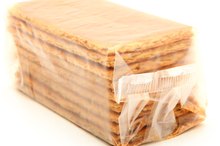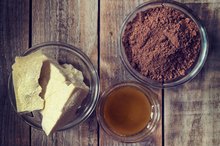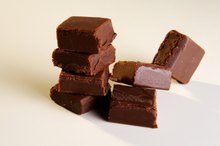What does fact checked mean?
At Healthfully, we strive to deliver objective content that is accurate and up-to-date. Our team periodically reviews articles in order to ensure content quality. The sources cited below consist of evidence from peer-reviewed journals, prominent medical organizations, academic associations, and government data.
- Mayo Clinic: Healthy Diet
- PubMed: Carob Pulp Preparation for Treatment of Hypercholesterolemia
- PubMed: Carob Pulp Preparation for Treatment of Hypercholesterolemia
- American Heart Association: Sugars and Carbs
The information contained on this site is for informational purposes only, and should not be used as a substitute for the advice of a professional health care provider. Please check with the appropriate physician regarding health questions and concerns. Although we strive to deliver accurate and up-to-date information, no guarantee to that effect is made.
Carob Chips Nutritional Information
Carob is a flavoring that is similar to chocolate in taste and texture. It has slightly more calories than chocolate, but it also has less fat and no caffeine. Carob pods grow on tropical trees in the Mediterranean. The pod contains pulp and inedible seeds. Like cocoa, which is needed for making chocolate, carob pods are dried, roasted and ground into a fine powder that is used for making chips 2.
Nutrients
An ounce of unsweetened carob has 151 calories, 9 grams of fat, no cholesterol, 30 mg of sodium, 16 grams of carbohydrates, 1 gram of fiber and 10 grams of sugar. Unsweetened chocolate, which carob often replaces, has 140 calories, 15 grams of fat, no cholesterol, 7 mg of sodium, 8 grams of carbohydrates and no sugar per ounce. Carob is used as a substitute for chocolate by people with a chocolate allergy, or by those who want a low-fat alternative to chocolate.
Cholesterol
Caffeine Free Soft Drinks
Learn More
It’s important to keep your consumption of saturated fats, trans fats and cholesterol as low as possible, according to the Food and Drug Administration. Foods with high levels of cholesterol can cause fatty deposits to appear in your arteries, which can lead to heart disease. The Mayo Clinic reports that your body makes all of the cholesterol it needs. While unsweetened and sweetened carob chips contain no cholesterol, recipes with carob may have added cholesterol 3. A hot carob beverage similar to hot chocolate, with milk, carob, honey and vanilla extract, has 20 mg of cholesterol.
- It’s important to keep your consumption of saturated fats, trans fats and cholesterol as low as possible, according to the Food and Drug Administration.
- While unsweetened and sweetened carob chips contain no cholesterol, recipes with carob may have added cholesterol 3.
Fats
Most adults should consume 44 to 78 grams of total fat daily. At 9 grams of total fat per ounce, carob has 14 percent of your recommended dietary allowance (RDA) of fat and more than 40 percent of your RDA of saturated fat. Carob may be lower in fat when compared to chocolate, but it is still relatively high in fat. Fat is a concentrated energy source that contains a lot of calories per gram. Too much saturated fat and trans fat can lead to high blood cholesterol levels and an increased risk of developing coronary heart disease.
- Most adults should consume 44 to 78 grams of total fat daily.
- At 9 grams of total fat per ounce, carob has 14 percent of your recommended dietary allowance (RDA) of fat and more than 40 percent of your RDA of saturated fat.
Sugar
Nutrition Information for Nabisco Honey Maid Graham Crackers
Learn More
There are no sugars added to carob when it is processed. However, the amount of naturally occurring sugar per serving of carob -- 2 ½ tsp. -- is still a significant amount. Most American women should consume no more than 6 tsp. of sugar a day. Men should limit their sugar intake to 9 tsp. a day, according to the American Heart Association 5.
- There are no sugars added to carob when it is processed.
- However, the amount of naturally occurring sugar per serving of carob -- 2 ½ tsp.
- --
Benefits
Carob, which is a source of insoluble fiber, may help soothe the digestive tract and reduce diarrhea. Carob contains magnesium, calcium, iron, phosphorous and vitamins A, B and D. A 2001 study by researchers at the University of Potsdam in Germany found that after eating 15 grams of carob daily for eight weeks, study participants with moderately high cholesterol saw their cholesterol levels decrease by 7 percent.
Related Articles
References
- The Cook’s Thesaurus: Chocolate
- Cacaoweb: Cacao Beans, Cocoa and Chocolate
- All Recipes: Hot Carob Recipe
- PubMed: Carob Pulp Preparation for Treatment of Hypercholesterolemia
- American Heart Association: Sugars and Carbs
- Anheyer D., et al. Herbal medicines for gastrointestinal disorders in children and adolescents: a systematic review. Pediatrics. 2017 Jun;139(6). doi:10.1542/peds.2017-0062.
- Goulas V., et al. The functional components of carob fruit: linking the chemical and biological space. Int J Mol Sci. 2016 Nov; 17(11): 1875. doi:10.3390/ijms17111875.
- National Kidney Foundation. Calcium oxalate stones.
Writer Bio
Shannon Marks started her journalism career in 1994. She was a reporter at the "Beachcomber" in Rehoboth Beach, Del., and contributed to "Philadelphia Weekly." Marks also served as a research editor, reporter and contributing writer at lifestyle, travel and entertainment magazines in New York City. She holds a Bachelor of Arts in literature from Temple University.









